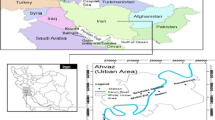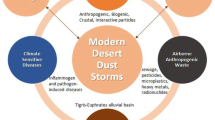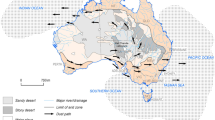Abstract
Widespread drought and record maximum temperatures in eastern Australia produced a large dust storm on 23 October, 2002 which traversed a large proportion of eastern Australia and engulfed communities along a 2000 km stretch of coastline from south of Sydney (NSW) to north of Mackay (Queensland). This event provided an opportunity for a study of the impacts of rural dust upon the air quality of four Australian cities.
A simple model is used to predict dust concentrations, dust deposition rates and particle size characteristics of the airborne dust in the cities. The total dust load of the plume was 3.35 to 4.85 million tones, and assuming a (conservative) plume height of 1500 m, 62–90% of this dust load was deposited in-transit to the coast. It is conservatively estimated that 3.5, 12.0, 2.1 and 1.7 kilotonnes of dust were deposited during the event in Sydney, Brisbane, Gladstone and Mackay, respectively. In the South East Queensland region, this deposition is equivalent to 40% of the total annual TSP emissions for the region.
The event increased TSP, PM10 and PM2.5 concentrations and reduced the visibility beyond the health and amenity guidelines in the four cities. For example, the 24-h average PM10 concentrations in Brisbane and Mackay, were 161 and 475 μg m−3 respectively, compared with the Australian national ambient air quality standard of 50 μg m−3. The 24-h average PM2.5 concentration in Brisbane was 42 μg m−3, compared with the national advisory standard of 25 μg m−3. These rural dusts significantly increased PM10/TSP ratios and decreased PM2.5/PM10 ratios, indicating that most of the particles were between PM2.5 and PM10.
Similar content being viewed by others
References
Ahmed, A. S., Ali, A. A. and Alhaider, M. A.: 1987, ‘Measurement of atmospheric particle size distribution during sand/duststorm in Riyadh, Saudi Arabia’, Atmospheric Environment 12, 2723–2725.
Australian Academy of Technological Sciences and Engineering: 1997, Urban Air Pollution in Australia – An Inquiry by the Australian Academy of Technological Sciences and Engineering, Commonwealth of Australia.
Brittlebank, C. C.: 1897, ‘Red Rain’, Victorian Naturalist 13, 125.
Chamberlain, A.: 1975, ‘The movement of particles in plant communities’, in J. Monteith (ed), Vegetation and the Atmosphere, Vol. {1}, Academic Press, London.
Chan, Y. C., Simpson, R. W., McTainsh, G. H., Vowles, P. D., Cohen, D. D. and Bailey, G. M.: 1999, ‘Source apportionment of PM2.5 and PM10 aerosols in Brisbane (Australia) by receptor modelling’, Atmospheric Environment 33, 2151–2268.
Chepil, W. S. and Woodruff, N. P.: 2957, ‘Sedimentary characteristics of dust storms. II. Visibility and dust concentration’, Amer. J. Sci. 255, 104–114.
Claiborn, C., Finn, D., Larson, T. and Koenig, J.: 2000, ‘Windblown dust contributes to high PM2.5 concentrations’, JAWMA 50, 1440–1445.
Clark, E.: 1995, The Impacts of Rural Dust on Air Quality in Brisbane, Honours Thesis, Faculty of Environmental Sciences, Griffith University, Brisbane.
Garratt, J. R.: 1984, ‘Cold fronts and dust storms during the Australian summer 1982–83’, Weather 39, 98–103.
Gu, Y., Rose, W. and Bluth, G.: 2003, ‘Retrieval of mass and size of particles in sandstorms using two MODIS IR bands: A case study of April 7, 2001 sandstorm in China’, Geophysical Research Letters 30/15, 1805.
Guo, J., Rahn, K. and Zhuang, G.: 2004, ‘A mechanism for the increase of pollution elements in dust storms in Beijing’, Atmospheric Environment 38, 855–862.
Harris, J. M. and Kahl, J. D.: 1990, ‘Analysis of 10-day isentropic flow patterns for Barrow, Alaska: 1985–1992’, Journal of Geophysical Research 99, 25845–25855.
Husar, R. B., Tratt, D. M., Schichtel, B. A., Falke, S. R., Li, F., Jaffe, D., Gasso, S., Gill, T., Laulainen, N. S., Lu, F., Reheis, M. C., Chun, Y., Westphal, D., Holben, B. N., Gueymard, C., McKendry, I., Kuring, N., Feldman, G. C., McClain, C., Frouin, R. J., Merrill, J., DuBois, D., Vignola, F., Murayama, T., Nickovic, S., Wilson, W. E., Sassen, K., Sugimoto, N. and Malm, W. C.: 2001, ‘Asian dust events of April 1998’, Journal of Geophysical Research 106(D16), 18317–18330.
Kim, K. and Kim, M.: 2001, ‘The effects of Asian dust on particulate matter fractionation in Seoul, Korea during spring 2001’, Chemosphere 51, 707–721.
Knight, A. W., McTainsh, G. H. and Simpson, R. W.: 1995, ‘Sediment loads in an Australian dust storm: Implications for present and past dust processes’, Catena 24, 195–213.
Lee, B., Jun, N. and Lee, H.: 2004, ‘Comparison of particulate matter characteristics before, during and after Asian dust events in Incheon and Ulsan, Korea’, Atmospheric Environment 38, 1535–1545.
Lee, S., Cope, M., Hess, D., Tory, K. and Walsh, S.: 2003, ‘Forecasting wind-blown dust events with the Australian Air Quality Forecasting System (AAQFS)’, Proceedings of the National Clean Air Conference: Linking Air Pollution Science, Policy and Management, CASNO3, Newcastle, Australia.
Leys, J. and McTainsh, G.: 1999, ‘Dust and nutrient deposition to riverine environments of south-eastern Australia’, in I. Livingstone (ed), 1998, Papers from the 4th International Conference on Aeolian Research, Oxford, UK. Gebruder Borntraeger, Berlin. J. of Annals of Geomorphology 116.
Liversidge, A.: 1902, ‘Meteoric dusts, New South Wales’, Journal of the Proceedings of the Royal Society of New South Wales 36, 241–285.
Lourensz, R. S. and Abe, K.: 1983, ‘A dust storm over Melbourne’, Weather 38, 272–275.
McGowan, H., McTainsh, G., Zawar-Reza, P. and Sturman, A.: 2000, ‘Identifying regional dust transport pathways: Application of kinematic trajectory modeling to a trans-Tasman case’, Earth Surf. Process Landforms 25, 633–647.
McTainsh, G. H.: 1989, ‘Quaternary aeolian dust processes and sediments in the Australian region’, Quaternary Science Reviews 8, 235–253.
McTainsh, G. H., Lynch, A. W. and Hales, R.: 1997, ‘Particle-Size analysis of aeolian dusts, soils and sediments in very small quantities using a Coulter Multisizer’, Earth Surface Processes and Landforms 22, 1207–1216.
McTainsh, G. H.: 1998, ‘Dust Storm Index’, in Sustainable Agriculture: Assessing Australia’s Recent performance. A Report of the National Collaborative Project on Indicators for Sustainable Agriculture. SCARM Technical Report 70, 65–72.
McTainsh, G. H., Lynch, A. W. and Tews, E. K.: 1998, ‘Climatic controls upon dust storm occurrence in eastern Australia’, Journal of Arid Environments 39, 457–466.
McTainsh, G., Leys, J. and Nickling, W.: 1999, ‘Wind erodibility of arid lands in the Channel Country of western Queensland, Australia’, in I. Livingstone (ed), 1998, Papers from the 4th International Conference on Aeolian Research, Oxford, UK. Gebruder Borntraeger, Berlin. J. of Annals of Geomorphology 116.
McTainsh, G. H.: 1999, ‘Dust transport and deposition’, in A. S. Goudie, I. Livingstone and S. Stokes (eds), 1999, Aeolian Environments, Sediments And Landforms. John Wiley & Sons, U.K., Chapter 9, 181–211.
McTainsh, G. H., McGowen, H. A., Chan, Y. C. and Leys, J. F.: 2005, ‘The 23 October 2002 dust storm in eastern Australia: Characteristics and meteorological conditions’, Atmospheric Environment (accepted for publication).
de Nevers, N.: 2000, Air Pollution Control Engineering, Chapter 9. Control of Primary Particulates. McGraw Hill International.
Nickling, W. G., McTainsh, G. H. and Leys, J. F.: 1999, ‘Dust emissions from the Channel Country of western Queensland, Australia’, Zeitschrift für geomorphologie n.f. 116, 1–17.
Patterson, E. M. and Gillette, D. A.: 1977, ‘Measurements of visibility vs mass concentration for airborne soil particles’, Atmospheric Environment 11, 193–196.
Queensland Environmental Protection Authority: 2003, Air Emission Inventory, south-east Queensland Region, Queensland Environmental Protection Authority.
Raupach, M., McTainsh, G. H. and Leys, J. F.: 1994, ‘Estimates of dust mass in recent major Australian dust storms’, Australian Journal of Soil and Water Conservation 7, 20–24.
Seinfeld, J. and Pandis, S.: 1998, Atmospheric Chemistry and Physics. Chapter 19. Dry Deposition. John Wiley & Sons Inc.
Sehmel, G. A.: 1980, ‘Particle and gas dry deposition: A review’, Atmospheric Environment 14, 983–1011.
United Nations Environment Programme: 2002, Global Environment Outlook 3. Past, Present and Future Perspectives. Earthscan Publications Limited, London.
Watkins, A. B.: 2002, ‘2002 Australian climate summary: Dry and warm conditions dominate’, Bulletin of the Australian Meteorological and Oceanographic Society 15, 109–114.
Author information
Authors and Affiliations
Corresponding author
Rights and permissions
About this article
Cite this article
Chan, YC., Mctainsh, G., Leys, J. et al. Influence of the 23 October 2002 Dust Storm on the Air Quality of Four Australian Cities. Water Air Soil Pollut 164, 329–348 (2005). https://doi.org/10.1007/s11270-005-4009-0
Received:
Accepted:
Issue Date:
DOI: https://doi.org/10.1007/s11270-005-4009-0




